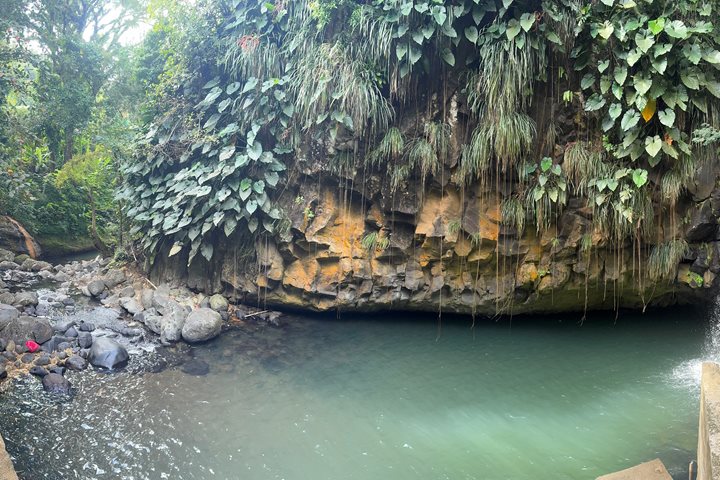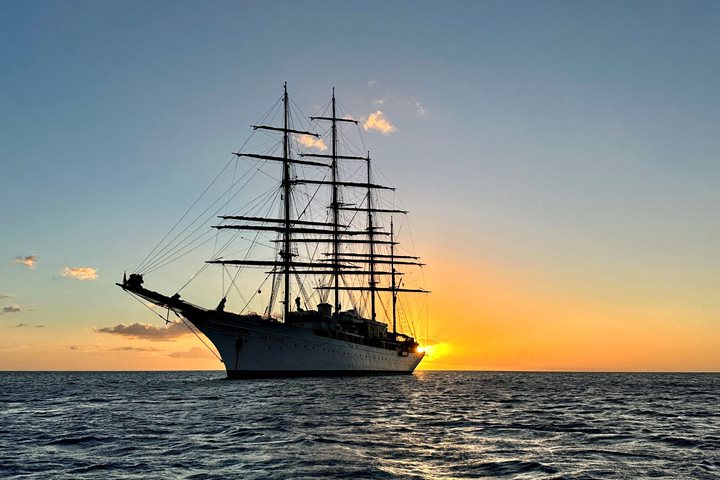Welcome to France. We dropped anchor in the harbor at 7:27 under an overcast sky in front of the village of Bourg or “City” in English on the island of Terre haut (the “high land”). This small archipelago of seven islands is a dependency of Guadalupe and is a distinct region of France and is in the Départment of d’Outré Mer, created by legislation in 1946. It has a parallel relationship to France as Hawaii has to the U.S. The inhabitants are French citizens, vote in all elections, and have all the perquisites of being French citizen. The official currency here is the Euro. While the shops are not inexpensive, the store called “Maogany” has the most beautiful indigo dyed clothing I have ever seen, and it appears from their presence in the store that a number of our guest agreed with me.
The town’s two most imposing buildings are a lovely Catholic Church “Our Lady of the Assumption” and a town hall, proclaiming “Liberté, Egalité and Fraternité,” those celebrated Gallic ideals that emerged from the French Revolution. Fisherman from Brittany originally settled the small islands in this archipelago and their descendants are still here today. The island also had a significant population of African slaves and the two races mixed. Today the citizenry is a rainbow of colors. The islands were a powerful force of resistance against the Vichy regime during WWII and the Vichy government was ousted from the islands in July 1943.
We took Zodiacs in at 8:30 a.m. and immediately Tom Heffernan led us up to the magnificent overlook of Fort Napoleon built begun in 1841 and finished by Napoleon III in 1867. The vistas from the top of the island are remarkable–we could see Guadalupe to our north and Dominica 13 miles to our south. During our visit to the fort and the museum Tom explained the crucial battle of the Saints, where the largest naval battle in the western hemisphere took place between April 7 and 12, 1782, concluding in the bloody defeat of the French ships under Admiral Comte de Grasse who surrendered his sword to the English Admiral George Rodney. The combined French and Spanish fleet had 47 men of war and a 100 transport vessels while the English had 35 men of war. The ships are really floating canon decks with upwards of 100 large canons. The roar from the guns, the stench of the gunpowder, the percussive force of the explosions and the lethal flying splinters of ship made the life of a gunner horrific.
Today the Fort contains a good museum and a botanical garden with many of the representative species of flowering trees on the Lesser Antilles represented. In addition to the trees there are wonderful cacti, euphorbia, and aloes. We also visited the nesting areas of the large land iguanas where luckily we spotted three of these wonderful creatures soaking in the sun, the largest of which was about three feet in length. Some of our guests went snorkeling with Patti and Ian on an adjoining island.
Lunch was on the Lido Deck aboard. The sailors went to the yards and hoisted the sails at 2 p.m. Tonight Captain Komakin hosted his farewell captain’s dinner and introduced his officers and congratulated all of us for having sailed on a true sailing vessel and not a “push button plastic” ship. We went to our cabins after yet another exhilarating day and prepared to disembark Monday morning.









